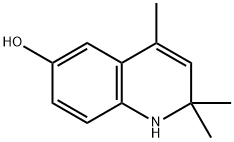1,2-Dihydro-2,2,4-trimethylquinoline
- CAS NO.:147-47-7
- Empirical Formula: C12H15N
- Molecular Weight: 173.25
- MDL number: MFCD00044248
- EINECS: 205-688-8
- SAFETY DATA SHEET (SDS)
- Update Date: 2024-12-18 14:07:02

What is 1,2-Dihydro-2,2,4-trimethylquinoline?
The Uses of 1,2-Dihydro-2,2,4-trimethylquinoline
1,2-Dihydro-2,2,4-trimethylquinoline is used as an antioxidant in styrene-butadiene and nitrile-butadiene rubbers and latexes. It was selected for evaluation because it is a derivative of quinoline, a known rodent carcinogen, and was regarded as having potential carcinogenic activity.
The Uses of 1,2-Dihydro-2,2,4-trimethylquinoline
1,2-Dihydro-2,2,4-trimethylquinoline (>85%) is used as an antioxidant in styrene-butadiene and nitrile-butadiene rubbers and latexes. It was selected for evaluation because it is a derivative of quinoline, a known rodent carcinogen, and was regarded as having potential carcinogenic activity.
General Description
Dark cloudy copper-colored or yellow liquid. Odorless.
Air & Water Reactions
1,2-Dihydro-2,2,4-trimethylquinoline may be sensitive to prolonged exposure to air and light. . Insoluble in water.
Reactivity Profile
1,2-Dihydro-2,2,4-trimethylquinoline neutralizes acids in exothermic reactions to form salts plus water. May be incompatible with isocyanates, halogenated organics, peroxides, phenols (acidic), epoxides, anhydrides, and acid halides. Flammable gaseous hydrogen may be generated in combination with strong reducing agents, such as hydrides.
Health Hazard
ACUTE/CHRONIC HAZARDS: When heated to decomposition 1,2-Dihydro-2,2,4-trimethylquinoline emits toxic fumes of nitrogen oxides.
Fire Hazard
1,2-Dihydro-2,2,4-trimethylquinoline is combustible.
Safety Profile
Moderately toxic by ingestion. When heated to decomposition it emits toxic fumes of NOx.
Properties of 1,2-Dihydro-2,2,4-trimethylquinoline
| Melting point: | 120 °C |
| Boiling point: | 293.92°C (rough estimate) |
| Density | 1.0215 (rough estimate) |
| refractive index | 1.5680 (estimate) |
| storage temp. | 2-8°C(protect from light) |
| solubility | Chloroform (Soluble), DMSO (Slightly), Ethyl Acetate (Slightly), Methanol (Spari |
| form | Oil |
| pka | 4.16±0.70(Predicted) |
| color | Brown to Very Dark Brown |
| Stability: | Light Sensitive |
| CAS DataBase Reference | 147-47-7(CAS DataBase Reference) |
| EPA Substance Registry System | 1,2-Dihydro-2,2,4-trimethylquinoline (147-47-7) |
Safety information for 1,2-Dihydro-2,2,4-trimethylquinoline
| Signal word | Warning |
| Pictogram(s) |
 Exclamation Mark Irritant GHS07 |
| GHS Hazard Statements |
H315:Skin corrosion/irritation H319:Serious eye damage/eye irritation |
| Precautionary Statement Codes |
P280:Wear protective gloves/protective clothing/eye protection/face protection. P302+P352:IF ON SKIN: wash with plenty of soap and water. P305+P351+P338:IF IN EYES: Rinse cautiously with water for several minutes. Remove contact lenses, if present and easy to do. Continuerinsing. P332+P313:IF SKIN irritation occurs: Get medical advice/attention. P337+P313:IF eye irritation persists: Get medical advice/attention. |
Computed Descriptors for 1,2-Dihydro-2,2,4-trimethylquinoline
1,2-Dihydro-2,2,4-trimethylquinoline manufacturer
NOCIL Limited
Nocil Limited
New Products
(S)-3-Aminobutanenitrile hydrochloride 4-Methylphenylacetic acid N-Boc-D-alaninol N-BOC-D/L-ALANINOL Tert-butyl bis(2-chloroethyl)carbamate 3-Morpholino-1-(4-nitrophenyl)-5,6-dihydropyridin- 2(1H)-one Furan-2,5-Dicarboxylic Acid Tropic acid 1-Bromo-3,5-Di-Tert-Butylbenzene S-2-CHLORO PROPIONIC ACID ETHYL ISOCYANOACETATE 2-Bromo-1,3-Bis(Dimethylamino)Trimethinium Hexafluorophosphate 4-IODO BENZOIC ACID 3-NITRO-2-METHYL ANILINE 1-(2,4-DICHLOROPHENYL) ETHANAMINE (2-Hydroxyphenyl)acetonitrile 4-Bromopyrazole 2-(Cyanocyclohexyl)acetic acid 4-methoxy-3,5-dinitropyridine 1-(4-(aminomethyl)benzyl)urea hydrochloride 2-aminopropyl benzoate hydrochloride diethyl 2-(2-((tertbutoxycarbonyl)amino) ethyl)malonate tert-butyl 4- (ureidomethyl)benzylcarbamate Ethyl-2-chloro((4-methoxyphenyl)hydrazono)acetateRelated products of tetrahydrofuran





![4,4,8-TRIMETHYL-4,5-DIHYDRO-1H-[1,2]DITHIOLO[3,4-C]QUINOLINE-1-THIONE](https://img.chemicalbook.in/StructureFile/ChemBookStructure2/GIF/CB7479706.gif)


You may like
-
 147-47-7 1,2 Dihydro-2,2,4-trimethylquinoline 98%View Details
147-47-7 1,2 Dihydro-2,2,4-trimethylquinoline 98%View Details
147-47-7 -
 2033-24-1 98%View Details
2033-24-1 98%View Details
2033-24-1 -
 1975-50-4 98%View Details
1975-50-4 98%View Details
1975-50-4 -
 2-HYDROXY BENZYL ALCOHOL 98%View Details
2-HYDROXY BENZYL ALCOHOL 98%View Details
90-01-7 -
 2-Chloro-1,3-Bis(Dimethylamino)Trimethinium Hexafluorophosphate 221615-75-4 98%View Details
2-Chloro-1,3-Bis(Dimethylamino)Trimethinium Hexafluorophosphate 221615-75-4 98%View Details
221615-75-4 -
 61397-56-6 CIS BROMO BENZOATE 98%View Details
61397-56-6 CIS BROMO BENZOATE 98%View Details
61397-56-6 -
 14714-50-2 (2-Hydroxyphenyl)acetonitrile 98+View Details
14714-50-2 (2-Hydroxyphenyl)acetonitrile 98+View Details
14714-50-2 -
 118753-70-1 98+View Details
118753-70-1 98+View Details
118753-70-1